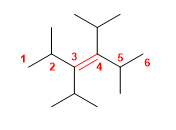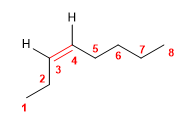Dessinez les formules des composés suivants :
| 1) 2-méthylhexa-1,5-diène 2) 2,3,4-Triméthylocta-1,4,6-triène 3) 4-tert-butyl-2-chlorohept-1-ène 4) 3-éthyl-2,4-diméthylhept-3-ène 5) 3,4-diisopropyl-2,5-diméthylhex-3-ène 6) Hept-1-ène 7) cis-oct-3-ène 8) 3-éthylpent-2-ène |
9) trans-1,4-dibromobut-2-ène 10) 3-chlorohex-2-ène 11) Buta-1,3-diène 12) Hexa-1,4-diène 13) 5-méthyl-3-propylocta-1,4,6-triène 14) 6-méthyl-6-propylnone-2,4,7-triène 15) 2,3,5-triméthylocta-1,4-diène 16) 3-Propylhepta-1,5-diène. |
SOLUTION:
1) 2-méthylhexa-1,5-diène

2) 2,3,4-Triméthylocta-1,4,6-triène

3) 4-tert-butyl-2-chlorohept-1-ène

4) 3-éthyl-2,4-diméthylhept-3-ène

5) 3,4-diisopropyl-2,5-diméthylhex-3-ène

6) Hept-1-ène

7) cis-oct-3-ène

8) 3-éthylpent-2-ène 
![]() La notation cis indique que les groupes égaux (hydrogènes) des positions 3,4 sont orientés du même côté de l'alcène.
La notation cis indique que les groupes égaux (hydrogènes) des positions 3,4 sont orientés du même côté de l'alcène.
9) trans-1,4-dibromobut-2-ène

10) 3-chlorohex-2-ène

![]() La notation trans indique que les groupes égaux de la double liaison (hydrogènes) sont orientés vers des côtés opposés.
La notation trans indique que les groupes égaux de la double liaison (hydrogènes) sont orientés vers des côtés opposés.
11) Buta-1,3-diène

12) Hexa-1,4-diène

13) 5-méthyl-3-propylocta-1,4,6-triène

14) 6-méthyl-6-propylnone-2,4,7-triène

15) 2,3,5-triméthylocta-1,4-diène

16) 3-Propylhepta-1,5-diène. 







